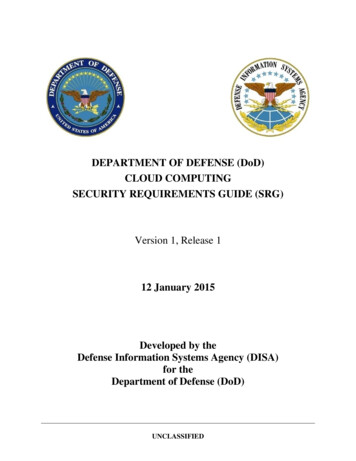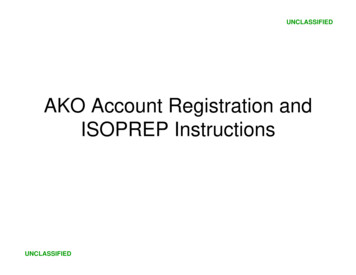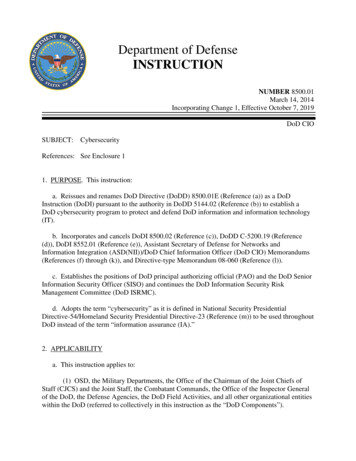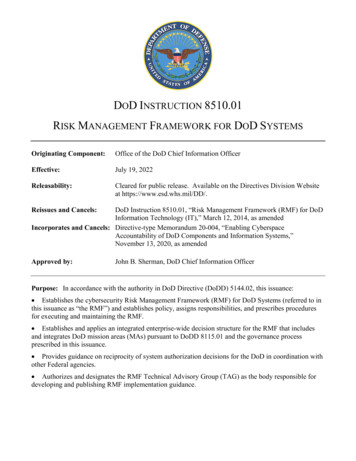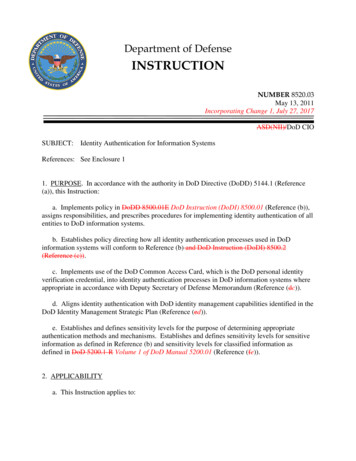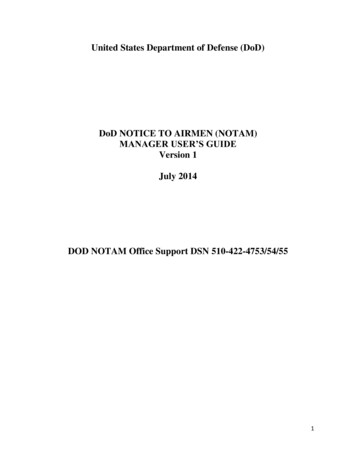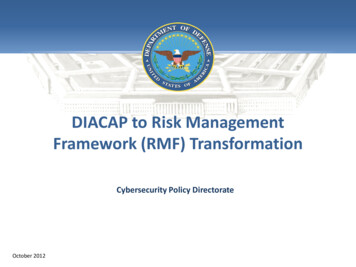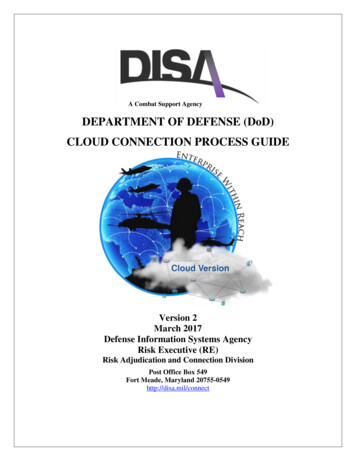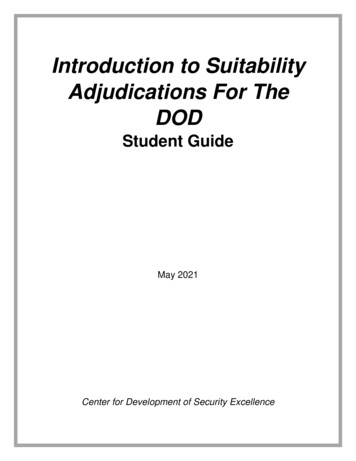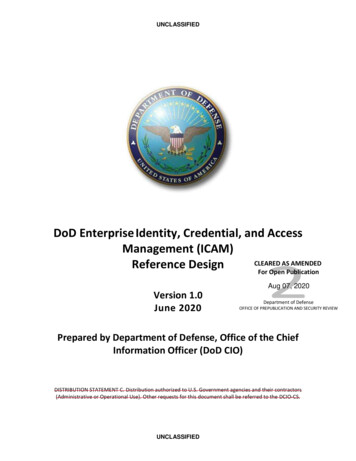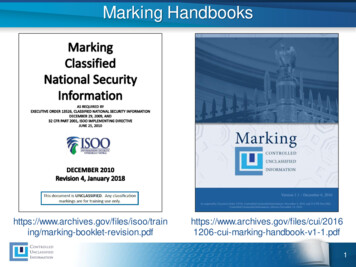
Transcription
Cyber Security ChallengesProtecting DoD’s Unclassified InformationUnclassified1
Outline Cybersecurity Landscape Protecting the DoD’s Unclassified Information DFARS Case 2013-D018, Network Penetration Reportingand Contracting for Cloud Services— Safeguarding Covered Defense Information (CDI)— Cloud Computing/Contracting for Cloud Services Resources QuestionsUnclassified
Cybersecurity LandscapeCyber threats targeting government unclassified information have dramatically increasedCybersecurity incidents havesurged 38% since 2014The Global State of Information Security Survey 2016Impacts of successful attacksincluded downtime (46%), loss ofrevenue (28%), reputational damage(26%), and loss of customers (22%).AT&T Cybersecurity Insights Vol. 4Cyber attacks cost companies 400 billion every yearInga Beale, CEO, LloydsCybercrime will cost businessesover 2 trillion by 201989% of breaches had a financial orespionage motive64% of confirmed data breachesinvolved weak, default or stolenpasswords2016 Data Breach Investigations Report, VerizonJuniper ResearchIn a study of 200 corporate directors, 80% said that cyber security is discussed atmost or all board meetings. However, two-thirds of CIOs and CISOs say seniorleaders in their organization don’t view cyber security as a strategic priority.NYSE Governance Services and security vendor VeracodeUnclassified3
What DoD Is DoingDoD has a range of activities that include both regulatory andvoluntary programs to improve the collective cybersecurity ofthe nation and protect U.S. interests Securing DoD’s information systems and networks Codifying cybersecurity responsibilities and procedures for theacquisition workforce in defense acquisition policy Contractual requirements implemented through the DefenseFederal Acquisition Regulation Supplement (DFARS) DoD’s DIB Cybersecurity Program for voluntary cyber threatinformation sharing Leveraging security standards such as those identified in NationalInstitute of Standards and Technology (NIST) Special Publication800-171 “Protecting Controlled Unclassified Information in NonfederalInformation Systems and Organizations” (Revision 1 published Dec 2016)Unclassified4
Protecting the DoD’s Unclassified Information Information System Security RequirementsContractor’s Internal SystemSecurity requirements fromNIST SP 800-171, DFARSClause 252.204-7012, and/orFAR Clause 52.204-21 applyFederalContractInformationSystem Operatedon Behalf of the DoDControlled Unclassified InformationInternalCloudCloud Service ProviderExternalCloud/CSPCSPControlledUnclassified Information(USG-wide)CoveredDefense InformationCSP(includes UnclassifiedControlled TechnicalInformation)Controlled UnclassifiedInformationWhen cloud services areused to process data on theDoD's behalf, DFARS Clause252.239-7010 and DoD CloudComputing SRG applyDoD InformationSystemSecurity requirementsfrom CNSSI 1253, basedon NIST SP 800-53, applyDoD Owned and/orOperated Information SystemUnclassifiedCloud Service ProviderWhen cloud services areprovided by DoD, the DoDCloud Computing SRG applies
Network Penetration Reporting andContracting for Cloud ServicesDFARS Case 2013-D018, Network Penetration Reporting and Contractingfor Cloud Services — final rule published on October 21, 2016Includes 3 clauses and 2 provisions:- (p) Section 252.204-7008, Compliance ngFor CloudServicesSafeguarding Covered Defense Information- (c) Section 252.204-7009, Limitation on theUse or Disclosure of Third-Party ContractorReported Cyber Incident Information- (c) Section 252.204-7012, SafeguardingCovered Defense Information andCyber Incident Reporting- (p) Section 252.239-7009, Representation ofUse of Cloud Computing- (c) Section 252.239-7010, Cloud ComputingServicesUnclassifiedAll solicitations/contractsexcept COTsSolicitations/contractsfor services that supportsafeguarding/reportingAll solicitations/contractsexcept COTsSolicitations andcontracts forIT services6
DFARS Clause 252.204-7012, Safeguarding CoveredDefense Information and Cyber Incident ReportingNov 18, 2013(Final Rule)Aug 26, 2015 / Dec 30, 2015(Interim Rules)October 21, 2016(Final Rule)Scope– WhatInformation? UnclassifiedControlled TechnicalInformation Covered DefenseInformation Operationally CriticalSupport Covered DefenseInformation (reviseddefinition) Oper Critical SupportAdequateSecurity– WhatMinimumProtections? Selected controls inNIST SP 800-53,Security and PrivacyControls for FederalInformation Systemsand Organizations Aug 2015 –NIST SP 800-171,Protecting ControlledUnclassified Information onNonfederal InformationSystems & Organizations NIST SP 800-171,Protecting ControlledUnclassified Informationon Nonfederal InformationSystems & OrganizationsWhen Req’d toMeet MinimumProtections? Contract Award Dec 2015 – As soon aspractical, but NLT Dec 31,2017 As soon as practical, butNLT Dec 31, 2017Subcontractor/Flowdown Include thesubstance of theclause in allsubcontracts Include in subcontractsfor operationally criticalsupport, or wheninvolving coveredinformation system Contractor to determineif information requiredfor subcontractorperformance retains itsidentity as CDI7Unclassified
What is Covered Defense Information? Unclassified controlled technical information (CTI) or otherinformation as described in the CUI Registry that requiressafeguarding or dissemination controls*, AND is either Marked or otherwise identified in the contract, task order, ordelivery order and provided to contractor by or on behalf of,DoD in support of the performance of the contract; OR Collected, developed, received, transmitted, used, or storedby, or on behalf of, the contractor in support of theperformance of the contract.*Pursuant to and consistent with law, regulations, and Governmentwide policies8Unclassified
Network Security Requirements to SafeguardCovered Defense InformationDFARS Clause 252.204-7012: Safeguarding Covered Defense Information andCyber Incident Reporting (effective October 21, 2016)(b) Adequate security. The Contractor shall provide adequate security on all coveredcontractor information systems. To provide adequate security, the Contractor shallimplement, at a minimum, the following information security protections:(2) For covered contractor information systems that are not part of an IT service orsystem operated on behalf of the Government (ii)(A) The Contractor shall implement NIST SP 800-171, as soon as practical,but not later than Dec 31, 2017.(3) Apply other information systems security measures when the Contractorreasonably determines that information systems security measures, in addition tothose identified may be required to provide adequate security in a dynamicenvironment or to accommodate special circumstances (e.g., medical devices) andany individual, isolated, or temporary deficiencies based on an assessed risk orvulnerability. These measures may be addressed in a system security plan.9Unclassified
NIST SP 800-171, Protecting CUI in NonfederalInformation Systems and Organizations Developed for use on contractor and other nonfederal informationsystems to protect CUI (Revision 1 published December 2016)— Replaces use of selected security controls from NIST SP 800-53, Securityand Privacy Controls for Federal Information Systems and Organizations Enables contractors to comply using systems and practices likelyalready in place— Requirements are performance-based, significantly reduce unnecessaryspecificity, and are more easily applied to existing systems. Provides standardized/uniform set of requirements for all CUIsecurity needs— Allows nonfederal organizations to consistently implement safeguards forthe protection of CUI (i.e., one CUI solution for all customers)— Allows contractor to implement alternative, but equally effective, securitymeasures to satisfy CUI security requirements10Unclassified
An Approach to Implementing NIST SP 800-171Most requirements in NIST SP 800-171 are about policy, process, and configuringIT securely, but some may require security-related software or hardware. Forcompanies new to the requirements, a reasonable approach would be to:1. Examine each of the requirements to determine— Policy or process requirements— Policy/process requirements that require an implementation in IT (typically byeither configuring the IT in a certain way or through use of specific software)— IT configuration requirements— Any additional software or hardware requiredNote that the complexity of the company IT system may determine whetheradditional software or tools are required.2. Determine which of requirements can readily be accomplished by in-house ITpersonnel and which require additional research3. Develop a plan of action and milestones to implement the requirements.11Unclassified
Implementing NIST SP 800-171ACATAUCMIAIRMAMP3.1.1Basic3.1.2(FIPS .6.23.7.13.7.23.8.13.8.23.8.3Derived 3.1.3(800-53) .10.6Policy/ProcessPolicy or Software RequirementConfigurationConfiguration or SoftwareSoftwareConfiguration or Software or HardwareHardwareSoftware or 3.153.13.163.14.43.14.53.14.63.14.7
Frequently Asked Questions — “Compliance”with DFARS Clause 252.204-7012Q: Does the Government intend to monitor contractors to ensureimplementation of the required security requirements?A: The DFARS rule did not add any unique/additional requirement for the Governmentto monitor contractor implementation of required security requirements.Q: Will the DoD certify that a contractor is 100% compliant with NIST SP800-171? Is a 3rd Party assessment of compliance required?A: The rule does not require “certification” of any kind, either by DoD or any other firmprofessing to provide compliance, assessment, or certification services for DoD or Federalcontractors. Nor will DoD recognize 3rd party assessments or certifications. By signingthe contract, the contractor agrees to comply with the terms of the contract.Some companies with limited cybersecurity expertise may choose to seek outsideassistance in determining how best to meet and implement the NIST SP 800-171requirements in their company. But, once the company has implemented therequirements, there is no need to have a separate entity assess or certify that thecompany is compliant with NIST SP 800-171.13Unclassified
Security Requirement 3.12.4 — System Security Plan (SSP)3.12.4 — Develop, document, periodically update, and implement systemsecurity plans for organizational information systems that describe thesecurity requirements in place or planned for the systems. The System Security Plan (SSP) should be used to document: How the requirements are met or how organizations plan to meet requirements- 3.12.2 addresses plans of action designed to correct deficiencies andreduce or eliminate vulnerabilities Situations where requirements cannot practically be applied (non-applicable) DoD CIO approved alternative but equally effective security measures Exceptions to accommodate special circumstances (e.g., CNC machines and/orshop floor machines) Individual, isolated or temporary deficiencies addressed by assessing risk andapplying mitigations When requested by the requiring activity, the SSP (or elements of the SSP) and anyassociated plans of action, should be submitted to the requiring activity/contractingofficer to demonstrate implementation of NIST SP 800-171.
Network Security Requirements to SafeguardCovered Defense Information For all contracts awarded prior to October 1, 2017, the Contractorshall notify the DoD Chief Information Officer (CIO), via email atosd.dibcsia@mail.mil, within 30 days of contract award, of anysecurity requirements specified by NIST SP 800-171 notimplemented at the time of contract award.(see 252.204-7012(b)(2)(ii)(A)) If the offeror proposes to vary from NIST SP 800-171, the Offerorshall submit to the Contracting Officer, a written explanation of - Why security requirement is not applicable; or- How an alternative but equally effective security measure isused to achieve equivalent protection(see 252.204-7008(c)(2)(i) and 252.204-7012(b)(2)(ii)(B))15Unclassified
Cyber Incident Reporting and Malware SubmissionDFARS 252.204-7012 (c) Cyber incident reporting requirement.(1) When the Contractor discovers a cyber incident that affects a coveredcontractor information system or the covered defense information residingtherein, or that affects the contractor’s ability to perform the requirements ofthe contract that are designated as operationally critical support, theContractor shall—(i) Conduct a review for evidence of compromise (ii) Rapidly report cyber incidents to DoD at https://dibnet.dod.milDFARS 252.204-7012 (d) Malicious Software. When the Contractor orsubcontractors discover and isolate malicious software in connection with areported cyber incident, submit the malicious software to DoD Cyber CrimeCenter (DC3) in accordance with instructions provided by DC3 or the ContractingOfficer. Do not send the malicious software to the Contracting Officer.Unclassified
Cyber Incident Damage Assessment ActivitiesDFARS 252.204-7012 (g) Cyber incident damage assessment activities.If DoD elects to conduct a damage assessment, the Contracting Officerwill request that the Contractor provide all of the damage assessmentinformation gathered in accordance with paragraph (e)* of this clause.*(e) Media preservation and protectionPurpose of damage assessment: To understand impact of compromised information on U.S. militarycapability underpinned by technology Initiated after review of reported cyber incident Focused on determining impact of compromised intellectualproperty, not on mechanism of cyber intrusion An assessment is not possible without access to compromisedmaterialUnclassified17
Cloud ComputingDFARS Clause 252.204-7012 ― Safeguarding Covered Defense Informationand Cyber Incident Reporting Applies when a contractor intends to use an external cloud service provider to store,process, or transmit Covered Defense Information in the performance of a contract Ensures that the cloud service provider:— Meets requirements equivalent to those established for the Federal Risk andAuthorization Management Program (FedRAMP) Moderate baseline— Complies with requirements for cyber incident reporting and cyber incidentdamage assessment.DFARS Clause 252.239-7010 ― Cloud Computing Services Applies when a cloud solution is being used to process data on the DoD's behalf or DoDis contracting with Cloud Service Provider to host/process data in a cloud Ensures that the cloud service provider:— Meets requirements of the DoD Cloud Computing Security Requirements Guide— Complies with requirements for cyber incident reporting and damage assessment.18Unclassified
DoD’s Defense Industrial Base (DIB) Cybersecurity ProgramA public-private cybersecurity partnership that: Provides a collaborative environment for sharing unclassified and classifiedcyber threat information Offers analyst-to-analyst exchanges, mitigation and remediation strategies Provides companies analytic support and forensic malware analysis Increases U.S. Government and industry understanding of cyber threat Enables companies to better protect unclassified defense informationon company networks or information systems Protects confidentiality of shared informationMission: Enhance and supplement Defense Industrial Base (DIB)participants’ capabilities to safeguard DoD information that resideson, or transits, DIB unclassified information systems
DIB CS Program EligibilityA contractor must be a Cleared Defense Contractor (CDC) and shall:(1) Have an existing active Facility Clearance (FCL) granted under NISPOM(DoD 5220.22-M);(2) Execute the standardized Framework Agreement (FA) with theGovernment,(3) To receive classified cyber threat information electronically:(i) Have or acquire a Communication Security (COMSEC) account in accordancewith the NISPOM Chapter 9, Section 4 (DoD 5220.22-M), which providesprocedures and requirements for COMSEC activities; and(ii) Have or acquire approved safeguarding for at least Secret information, andcontinue to qualify under the NISPOM for retention of its FCL and approvedsafeguarding; and(iii) Obtain access to DoD's secure voice and data transmission systemssupporting the voluntary DoD-DIB CS information sharing program.
DIB CS Web PortalReport aCyber IncidentApply toDIB CS ProgramAccess to this page requires aDoD-approved mediumassurance certificate. Formore information please visitthe ECA website.Cleared defense contractors applyto join the DIB CS Program forvoluntary cyber threat informationsharing. Access requires a DoDapproved medium assurancecertificate. For more informationplease visit the ECA website.DIBNet.dod.milLogin toDIB CS InformationSharing PortalCurrent DIB CS Programparticipants login to the DIBNetportal. Access requires a DoDapproved medium assurancecertificate. For more informationplease visit the ECA website.
Resources DPAP Website /index.html)for DFARS, Procedures, Guidance and Information (PGI) Frequently Asked Questions (FAQs)(http://www.acq.osd.mil/dpap/pdi/docs/FAQs Network Penetration Reporting andContracting for Cloud Services (01-27-2017).pdf) NIST SP blications/NIST.SP.800-171.pdf) Cloud Computing Security Requirements Guide (SRG)(http://iasecontent.disa.mil/cloud/SRG/) DoD’s Defense Industrial Base Cybersecurity program (DIB CS program)(https://dibnet.dod.mil) Defense Security Information Exchange (DSIE) (https://www.DSIE.org) United States Computer Emergency Readiness Team (US-CERT)(https://www.us-cert.gov) Questions? Submit questions via email at osd.dibcsia@mail.milUnclassified22
Questions?Unclassified23
Back-upUnclassified24
Changes in Final Text, DFARS Case 2013-D018 Applicability to Fundamental Research: DFARS Clause 252.204-7000, Disclosure ofInformation, clarifies that fundamental research, by definition, must not involve CDI Applicability to COTS Items: Provision/clause are not prescribed for use in solicitations orcontracts solely for the acquisition of commercially available off-the-shelf (COTS) items. Definition of Covered Defense Information: Revised for clarity Subcontractor Flowdown: Contractor shall determine if information required forsubcontractor performance retains identity as CDI, and if necessary, may consult with CO. Contracting for Cloud Services:- When using cloud computing to provide IT services operated on behalf of theGovernment, DFARS Clause 252.239-7010 allows for award to cloud service providersthat have not been granted a DoD provisional authorization (PA)- When contractor uses internal cloud or external CSP to store/process/transmit CDI,DFARS Clause 252.204-7012 requires contractor to ensure cloud/CSP meets FedRAMPModerate baseline and requirements in clause for reporting, etc.Unclassified25
on NIST SP 800-53, apply Security requirements from NIST SP 800-171, DFARS Clause 252.204-7012, and/or FAR Clause 52.204-21 apply When cloud services are used to process data on the DoD's behalf, DFARS Clause 252.239-7010 and DoD Cloud Computing SRG apply DoD Owned and/or Operated Information System System Operated on Behalf of the DoD
